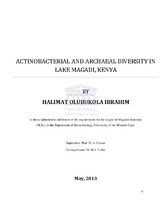| dc.contributor.advisor | Cowan, D. A. | |
| dc.contributor.author | Halimat, Olubukola Ibrahim | |
| dc.date.accessioned | 2015-06-03T14:34:52Z | |
| dc.date.available | 2015-06-03T14:34:52Z | |
| dc.date.issued | 2013 | |
| dc.identifier.uri | http://hdl.handle.net/11394/4253 | |
| dc.description | >Magister Scientiae - MSc | en_US |
| dc.description.abstract | Microorganisms of the class Actinobacteria and domain Archaea are interesting from a
biotechnological perspective owing to their metabolic attributes as producers of
secondary metabolites and resilience under harsh environmental conditions respectively.
Lake Magadi is a soda lake well studied in terms of its geology and limnology. Research
attention has also been drawn to the microbial populations which thrive in this unique
habitat but currently there are no reports on the assessment of its microflora using
molecular methods.
This study aimed to assess the actinobacterial and archaeal communities within Lake
Magadi, Kenya a hypersaline –highly alkaline habitat using metagenomic methods as a
preliminary study to identify potential candidates for exploitative biology
Samples from two sites dubbed Lake Magadi station 2 (LM2) and Lake Magadi salt pan
4 (LMS4) within the Lake Magadi were analyzed using the 16S rRNA gene as a
phylogenetic marker.
Cluster analysis of taxon-specific 16S rDNA PCR-DGGE profiles revealed moderately
heterogeneous actinobacterial and archaeal populations across the sample sites under
investigation which is probably a reflection of the differences in abiotic conditions at the
study sites. This observation was also confirmed from the multi-dimensional scaling
(MDS) plot.
PCR-based clonal libraries of actinobacterial and archaeal communities of both study
sites retrieved a total of thirty-two clones (twenty actinobacterial and twelve archaeal)
were sequenced. Analysis of the sequences revealed cultured and uncultured signatures of
microorganisms typical of hypersaline and or highly alkaline niches. A few (3) sequences
presented novelty (<96%) in identities with any previously identified organism. It was
concluded that the species dominance at site LMS4 [situated within the salt flats of Lake Magadi and site for exploration of trona and its mineralized extensions (nacholite and
gayllusite)] is likely to be dictated by anthropogenic stress since most of the microbial
signals associated with the study site are typical of saline and or alkaline environmental
samples exposed to especially mining but also agricultural and waste management
practices.
Isolation studies also revealed previously identified strains peculiar to hypersaline brines
and sediments. The strains retrieved were affiliated to the taxonomically diverse genus
Bacillus and Halomonas sp. The true applications and potential opportunities these
isolates have for biotechnology have been well documented.
Observations made from the culture dependent and culture independent methods suggests
strongly that study site LMS4 is subjected to environmental conditions more severe than
at site LM2.
This study is a guide for future studies as it provides primary information on the
haloalkaliphilic representatives of the actinobacteria phylum and domain Archaea within
the soda lake environment. It can serve as a pedestal for investigation into the molecular
machinery that supports the haloalkaliphilic lifestyles of inhabiting microorganisms and
consequently give leads as to how they can be commercially exploited. | en_US |
| dc.language.iso | en | en_US |
| dc.publisher | University of the Western Cape | en_US |
| dc.subject | Extremophiles | en_US |
| dc.subject | Extreme environments | en_US |
| dc.subject | Lake Magadi, Kenya | en_US |
| dc.subject | Microbial diversity | en_US |
| dc.subject | Biotechnological potentials | en_US |
| dc.title | Actinobacterial and archaeal diversity in lake Magadi, Kenya | en_US |
| dc.rights.holder | University of the Western Cape | en_US |

